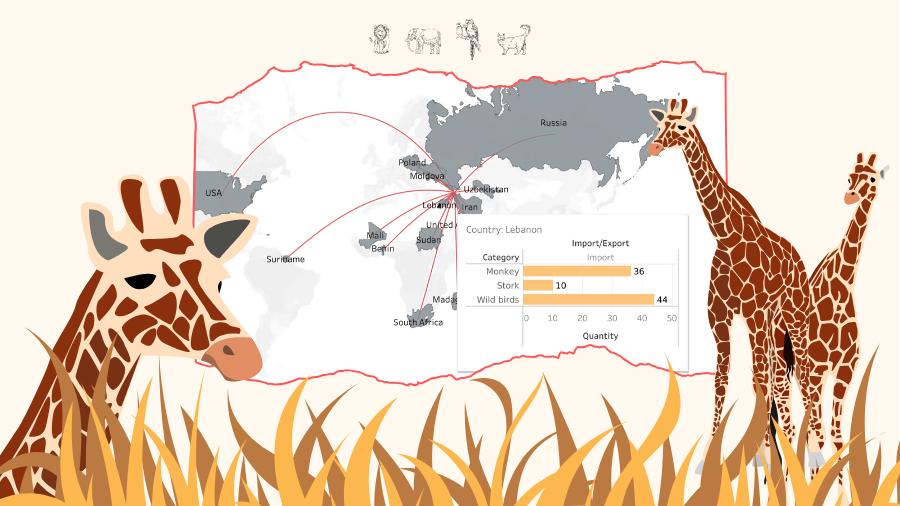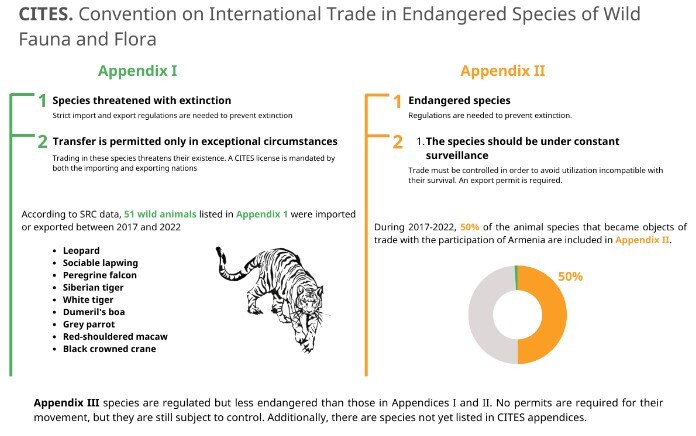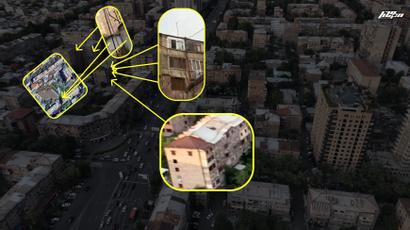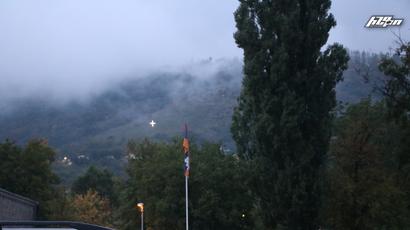
Animal trade: the uncertain destiny of animals imported into Armenia and the tacit consent of the state
Between 2017 and 2022, nearly 4,000 wild animals were imported into Armenia from various parts of the world. The destiny of the majority of these animals remains obscure due to insufficient statistical records and incomplete customs data.
The Ministry of the Environment of the Republic of Armenia (MoE), the Food Safety Inspection Body (FSIB), and in some cases, the National Academy of Sciences (NAS) and the Environmental Protection and Mining Inspection Body, are the authorities that issue permits and conclusions for the trade of wild animals, but they do not have access to comprehensive information about imported and exported animals.
The customs service of the State Revenue Committee (SRC) similarly lacks comprehensive information regarding the importation and exportation of animals. This deficiency is attributed to what they describe as "objective and subjective" factors, including incomplete documentation in customs records.
From the Republic of South Africa (RSA) to private companies in Russia via Armenia
In 2021, 45 giraffes were imported into Armenia. During the transfer, one of them perished, and another one died shortly after arriving in Armenia. The fate of the remaining giraffes is currently unknown.
Several months following their importation into Armenia, agreements were reached to sell 30 of the giraffes. Re-export permits were issued for 12 of them to "Ovatsiya" LLC, based in the city of Tula, Russia. This company is involved in the retail trade of food, including meat and meat products. Another 12 giraffes were intended to be sent to “Yaltinsky Zoo SKAZKA” LLC. Additionally, permission to export the remaining 6 giraffes was granted to an individual undertaker Eduard Sergeyevich Khachaturyan. Khachaturyan's name has previously been cited in the media in connection with suspicious transactions involving the transportation of wild animals from Armenia to the Russian Federation.
However, none of these transactions were completed due to a ban imposed by Rosselkhoznadzor of the Russian Federation in 2020. The ban prohibits the entry of animals from RSA, as well as animals sensitive to aphthous fever, into Russia.
Giraffes were imported to Armenia by "Fauna Zoo" LLC, whose owners previously conducted animal trade transactions through "Zoo Fauna Art" LLC, which went bankrupt in 2017 and is currently undergoing liquidation. The bankruptcy manager, Samson Ghukasyan, informed "Infocom" that the area where this company is registered is mortgaged and will soon be sold. However, the sale is being delayed due to an issue concerning the status of the land.
At least four government agencies in Armenia have facilitated this import transaction by issuing permits and providing favorable professional opinions. These agencies include the Ministry of Environment of the Republic of Armenia (MoE), the Food Safety Inspection Body (FSIB), the National Academy of Sciences (NAS), and the Environmental Protection and Mining Inspection Body. However, none of these entities offer complete information regarding the current status of the animals.
How is the Scientific Center of Zoology and Hydroecology of the NAS of RA involved in the importation of giraffes?
Observations by the International Union for Conservation of Nature (IUCN) indicate a significant decline in giraffe populations over recent decades. Studies from 1985 to 2015 reveal a decrease of 36-40% in giraffe numbers, attributed to increased human exploitation (anthropogenic factors) and habitat loss.
Since 2016, giraffes have been included on the IUCN Red List with a "Vulnerable" (VU) status. The IUCN estimates there are approximately 68,293 mature individuals of giraffes. Since 2019, giraffes have been classified under Appendix II of the Convention on International Trade in Endangered Species of Wild Fauna and Flora (CITES). This placement further emphasizes the necessity to prioritize conservation efforts and protect these animals.
The Scientific Center of Zoology and Hydroecology of the National Academy of Sciences of the Republic of Armenia submitted a written conclusion to the Ministry of Environment, stating that giraffes cannot survive in Armenia's natural environment. At the same time, the conclusion affirms that the facilities of "Fauna Zoo" LLC adhere to all international norms and standards of animal care, enabling the temporary housing of the animals on the premises. Thus, the scientific center did not oppose the importation of 45 giraffes without any scientific justification.
In the official documents, the purpose of importing giraffes was stated to be for animal trade and breeding. In other words, the main purpose of importing the animals is further resale.
In the professional conclusion of the Scientific Center of the National Academy of Sciences, environmental damage resulting from the importation, the impact of climate change on the animals, and the effects of keeping them in captivity were not considered.
Observations by the International Union for Conservation of Nature (IUCN) indicate a significant decline in giraffe populations over recent decades. Studies from 1985 to 2015 reveal a decrease of 36-40% in giraffe numbers, attributed to increased human exploitation (anthropogenic factors) and habitat loss.
Since 2016, giraffes have been included on the IUCN Red List with a "Vulnerable" (VU) status. The IUCN estimates there are approximately 68,293 mature individuals of giraffes. Since 2019, giraffes have been classified under Appendix II of the Convention on International Trade in Endangered Species of Wild Fauna and Flora (CITES). This placement further emphasizes the necessity to prioritize conservation efforts and protect these animals.
The Scientific Center of Zoology and Hydroecology of the National Academy of Sciences of the Republic of Armenia submitted a written conclusion to the Ministry of Environment, stating that giraffes cannot survive in Armenia's natural environment. At the same time, the conclusion affirms that the facilities of "Fauna Zoo" LLC adhere to all international norms and standards of animal care, enabling the temporary housing of the animals on the premises. Thus, the scientific center did not oppose the importation of 45 giraffes without any scientific justification.
In the official documents, the purpose of importing giraffes was stated to be for animal trade and breeding. In other words, the main purpose of importing the animals is further resale.
In the professional conclusion of the Scientific Center of the National Academy of Sciences, environmental damage resulting from the importation, the impact of climate change on the animals, and the effects of keeping them in captivity were not considered.
Giraffes and other wildlife, unseen and unheard
In 2021, efforts were made to determine the whereabouts and living conditions of the 43 giraffes imported into Armenia. Despite repeated attempts to contact the “Fauna Zoo” company, our inquiries were unsuccessful as they refused to respond to our questions.
The "Fauna Zoo" is registered at 148 G. Mahari Street (Erebuni administrative district). This address is stated in all documents as the location of animal importation. Assuming that the giraffes brought from RSA are housed at this address, we submitted a written request to the FSIB in 2022 regarding the animals kept in the area.
The FSIB didn't provide specific numbers for the giraffes, but they did mention giraffes, zebras, goats, tigers, lions, monkeys, parrots, and rhinos being housed at the address. That's the latest update we have on the giraffes at 148 G. Mahari Street. However, when we pressed for further information, both the FSBI and EPMIB stonewalled us, saying they needed written consent from the company.
Our visit to the premises of "Fauna Zoo" LLC yielded no new information. G. Mahari Street is a residential area, a typical street in Yerevan. Surprisingly, even the residents of the neighborhood are unaware of the presence of wild animals living nearby. They have neither seen, heard, nor sensed the presence of such a large number of animals in their vicinity. This is despite the fact that, according to data from the SRC, MoE, and FSIB, there are supposedly 43 giraffes, 20 zebras, 49 ibex, 20 crocodiles, 20 caracals, 20 servals, 20 genets, lions, and tigers kept in this area.
Unveiling the official data
According to the data provided by the SRC, 3,941 wild and exotic animals with different conservation statuses were imported to Armenia from different countries in 2017-2022. Due to the lack of complete records, the fate, status, location and conditions of most of these animals are unknown.
Quantity and customs value of wild animals
imported to and exported from Armenia, 2017-2023
Only 703 of the imported animals, mostly small birds, were exported. Put differently, official data indicates there should be 3,238 imported animals in Armenia. However, no state institution, including the MoE, responsible for issuing animal import permits, provides complete information about the location and status of these animals.
The main import partner countries to Armenia are the RSA (18 animal species) and Benin (16 animal species). These African countries are known for their rich wildlife, but also for poachers and animal traffickers.
The Convention on International Trade in Endangered Species of Wild Fauna and Flora (CITES) categorizes animal species into three appendices based on their level of threat: Appendices I, II, and III.
In Appendix I are endangered animal species, and the transportation of these specimens is permitted only under exceptional circumstances. The CITES permit is issued by both the exporting and importing countries.
Species listed in Appendix II are endangered and require constant monitoring. The CITES permit is issued solely by the exporting country.
Animal species listed in Appendix III are less endangered, but their transport is still regulated and documented, with no permit required.

Between 2017 and 2022, Armenia imported 9 endangered (Appendix I) and 32 threatened (Appendix II) animal species. The remaining animal species either fall under Appendix III or have not yet been listed in the Convention.
The purpose of the Convention is frequently misunderstood and misinterpreted, particularly in Armenia and the African countries, which are common sources of imported animals. Maria Vorontsova, a candidate of biological sciences and international expert, and a regular participant in UN Conferences of Parties, explains: "This convention was established when it became evident that animals were being extracted from nature and transported globally. CITES serves as the document that regulates and aims to mitigate this process. CITES primarily deals with cross-border transportation. Many people mistakenly view it as a trade convention, but that's not the case. Its main focus is on regulating the movement of wildlife across borders, with the aim of protecting wildlife rather than promoting trade. CITES countries are required to have domestic legislation that either matches or exceeds the standards set by the Convention. For instance, Australia, home to numerous parrot species, has implemented a complete ban on their export as a means to reinforce CITES regulations. The convention doesn't mandate such action, but Australia takes pride in its fauna and sees no reason to remove parrots from the country. Experience has shown that exporting them typically leads to unfavorable outcomes—they often perish."
According to another expert, Iman Memarian, a veterinarian consultant with European Association of Zoos and Aquaria (EAZA), there is also a significant risk of corruption in animal trade. "Unfortunately, the Convention doesn't assess the conditions of captivity or the country's overall capacity to care for the animals. Corruption is prevalent, even prior to licensing."
Animals resold at prices substantially lower than their original purchase cost
Instances where animals can be traced through customs data often reveal suspicious business transactions. For example, in 2020, four African marabou were imported from Benin, with a total customs value of 647,400 AMD, equating to 168,600 AMD per bird. The following year, ten more marabou were imported, valued at 1,082,000 AMD in customs value, making the cost of each bird 108,260 AMD.
Seven of these birds were exported to Ukraine at a significantly lower customs value, priced at 35,800 drams each, totaling 250,840 drams. In other words, the selling price is several times lower than the import price.
Such a significant price gap suggests less of a profitable business venture and more of a charitable endeavor or financial loss. This transaction likely involved "Yerznkyan Zoo Center" LLC, as export permits indicate that this company obtained re-export authorization for 7 African marabou birds from the Ministry of Environment in 2021.
This circumstance should have prompted the SRC to thoroughly and efficiently investigate the import and export data for the same item. Such a significant price difference between imports and exports may suggest a risk of tax evasion.
Who bears ultimate responsibility?
The issue of wild animal trade and Armenia's involvement in it could be a subject of continuous study and discussion, given numerous incidents like the disappearance of the 43 giraffes. Yet, the most pressing question remains unanswered: where are these animals now, and in what condition do they find themselves?
It appears that both local and international legal regulations have tasked state bodies with providing answers to this question. However, the available facts do not shed light on the matter.
The CITES establishes universal regulations and standards governing the global transportation of wild animals, leading to the establishment of permit-granting systems within individual countries. Oversight of this system falls to the respective state authorities. In Armenia, the Ministry of Environment serves as the coordinating body, while scientific guidance is provided by the National Academy of Sciences.
The Ministry's issuance of numerous permits for the import and export of protected wild animals is evidently a concerning factor with potential environmental repercussions.
Many cases of animals being exploited for entertainment or private trade have been documented in Armenia, highlighting the apparent indifference of the Ministry of Environment and other relevant authorities. For instance, the FSIB and Environmental Protection and Mining Inspection Body decline to disclose information regarding the quantity and welfare of animals housed within the premises of "Fauna Zoo" LLC. The National Academy of Sciences, which provided a favorable professional opinion for the importation of large quantities of wild animals without scientific justification, and the Customs Service of the State Revenue Committee, which permits the transportation of animals across borders without sufficient supervision.
In essence, the CITES Convention primarily concerns the cross-border movement of wild animals, suggesting that permits should only be granted in cases of dire necessity, rather than for commercial or business motives. It’s remarkable that Armenia's governmental institutions deviate from the core tenets of the Convention; instead, they permit and even facilitate numerous transfers of wild animals, leveraging their authority to issue CITES permits.
It appears that the convention grants each country the autonomy to establish and adhere to its own regulatory framework.
Undoubtedly, there is a significant population of animals already held in captivity under substandard conditions within the country. However, this inadequately regulated trade continues to fuel their numbers.
Author: Mariam Tashchyan
Infographics: Bibinur Bolotkanova
Mentor: Kate Mamyan





!["I don't want my children to starve, to be subjected to genocide, I want to live in Artsakh, to build our Homeland" [Blockade from the inside]](https://cdn.infocom.am/enlarge?file=2023-08-10-4865f192-ab13-4e84-beab-6232fbca7831.jpg&type=jpeg&width=410&height=230)
!["It's truly unbearable to be captive on your own land; everyone wants to live, yet the possibility of life is uncertain" [Blockade From The Inside]](https://cdn.infocom.am/enlarge?file=2023-08-07-4da13b91-9ae8-4497-a322-a6173bea598d.jpg&type=jpeg&width=410&height=230)
![A mother of five from Artsakh prepares sweets using the last remaining ingredients at home and shares them with neighboring children. [Blockade from the inside]](https://cdn.infocom.am/enlarge?file=2023-08-07-a38344bf-93f4-46f3-be0d-27ad2e27cf27.jpg&type=jpeg&width=410&height=230)
comment.count (0)